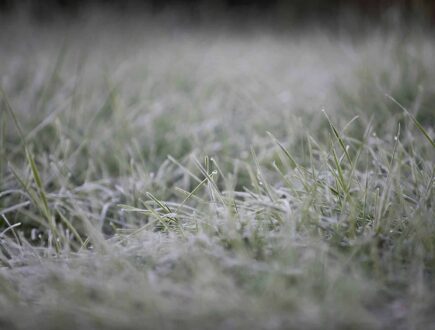Log in or create new account to save this product to your wishlist.

Mowing your lawn BEFORE overseeding — this is how it works!
Overseeding is an essential lawn care task. But make sure you cut your grass beforehand (otherwise, you'll have a jungle on your hands!).
🌱 All important maintenance moments for your lawn during the year. Leave your email and we will send you the lawn calendar for free.
Enter your email
Receive the lawn calendar in the mail
Enjoy a green lawn all year round!

- Order by 2PM = shipped today
- 250.000+ satisfied customers!
- 60 day satisfaction guarantee
It’s a schoolboy/girl error — forgetting to mow before overseeding. It’s not the end of the world, but your lawn will look mighty untidy for a while if you don’t cut beforehand.
Because your existing grass will grow around your newly seeded grass plants — and you can’t mow until they’re established.
Don’t worry — it can happen, which is why I’m writing this short blog piece, reminding you why you should mow before overseeding!
What is overseeding?

Overseeding is one of the most effective ways to keep your lawn young and robust, providing a dense turf that will keep weeds and moss at bay.
However, it can take up to four weeks for the new seed to germinate and grow to the point it’s ready for its first mowing. And all the while, your existing lawn continues to grow.
Sure, you can mow around the overseeded areas if they’re in patches, but it’s better to leave your lawn undisturbed to ensure the new grass plants aren’t damaged.
So, cut your lawn a little shorter than usual before overseeding.
Why overseeding creates a denser lawn
When you overseed, you spread fresh lawn seeds over your existing lawn, paying particular attention to any bald spots. This means that your lawn will fill out with new, young blades.
This is important because grass plants don’t last forever — over time, they become depleted and more susceptible to disease. Most grass plants last five years at their peak, and it’s downhill from there.
So, by overseeding, you keep your lawn young, healthier, and more resistant. You’ll develop a denser, more beautiful turf, which has a better chance against diseases, moss, and weeds.
Why is overseeding important?

There are two principal reasons for overseeding:
- Lawn rejuvenation: overseeding replaces old, dying grass with fresh, young plants, which help protect against weeds, moss, and disease.
- Lawn preservation: as soon as bald spots appear in your grass, weeds and moss will force their way into your lawn. By overseeding, you’ll prevent the likelihood of bald spots, which helps prevent weed invasions!
When should I overseed my lawn?
The best time to overseed is during the spring or autumn because the soil is warm enough to germinate the seeds, and there’s more likely to be regular rain to relieve you of the constant watering you’ll need to do to help your young plants on their way to maturation.
However, if you’re attacking weeds, pests, or a lawn disease, you can overseed whenever the bald spots appear due to weed death or pest removal.
However, lawn seed will only germinate when the soil temperature is at or higher than 10℃, so it won’t work in the depths of winter.
Remember: always use a lawn starter fertiliser to boost the soil’s nutrition so your baby plants will grow into healthy adults.
-
BestsellerPower Lawn Grass Seed
Out of stock
13.99- Order by 2PM = shipped today
- 250.000+ satisfied customers!
- 60 day satisfaction guarantee
-
Sports & Fun Grass Seed
Out of stock
14.99- Order by 2PM = shipped today
- 250.000+ satisfied customers!
- 60 day satisfaction guarantee
-
Quick Repair Grass Seed
Out of stock
13.99- Order by 2PM = shipped today
- 250.000+ satisfied customers!
- 60 day satisfaction guarantee
How to prepare the lawn for overseeding
Lawns don’t grow in a day! High-quality seeds tend to take up to 4 weeks to germinate and grow to a strength sufficient for the first mowing.
And this is why it’s essential to mow before overseeding because your established grass plants will be huge after four weeks. Remember, new grass plants need direct access to sunlight and air — if the surrounding grass is too long, it will put your new plants in the shade. This leads to humidity and, ultimately, mould, which can kill your new plants.
So, mow to 3cm before overseeding. This is shorter than a typical cut but will ensure plenty of light and air for your young plants to thrive.
Preparing the soil for overseeding
Healthy grass grows on healthy soil, so two things are essential:
- The nutrient content of the soil
- The type of soil
Fertilise your soil
Supply additional nutrition via regular fertilisation. I recommend fertilising your lawn at least three times a year for optimal results. If that’s too much, aim for early spring and late autumn. That way, the soil will be in good condition to support your grass plants when they need it the most.
Check out our expert guides on fertilising your lawn and understanding your soil needs.
Test your soil
To determine your soil type, just grab a handful of earth and squeeze it in your palm. If the mud sticks together firmly, you have clay soil; if it falls apart when you release your palm, you have sandy soil.
If you have clay soil, you’ll need to aerate regularly to ensure it doesn’t become compacted. You may need to improve the ground with water-retentive organic matter if it’s very sandy.
Find out more about improving your soil in our expert guide to improving soil quality.

- Slow release but fast acting
- Results within 7 days
- Lasts for up to 90 days
Which lawn seeds should I choose?
It depends on your garden conditions. If your lawn is in full sun all day, then you have the widest choice of grass seeds — choose either a robust lawn seed for heavy use or an ornamental lawn seed for beautiful grass that can be cut short.
If you have a shady garden, you’ll need a lawn seed that copes in both sun and shade, so try out our Shade & Sun grass seed.
Check out our wide range of lawn seeds for all gardens.
Top tips for mowing before overseeding
Before overseeding, follow these tips:
- Remove all debris from the lawn surface, including stones, branches, and leaves.
- Remove garden furniture and anything that will put the lawn in the shade.
- Cut out the weeds, and immediately fill the holes with good topsoil.
- Move your lawn to 3cm.
- Sow your grass seeds by hand or with a hand spreader.
- Lay a lawn starter fertiliser. This supports the seedlings as they grow.
- Keep your lawn moist for 14 days — spray it three-to-four times daily. Little and often is better than one extensive watering, which could displace the seeds.
- Remove weeds as they grow, and avoid walking on your lawn for four weeks.
- After four weeks, mow. And enjoy your lawn!
Thanks for reading!
I hope you’ve got all the info you need for a successful overseeding project. But if you have questions, get in touch!
We’ll reply asap!
Happy overseeding.
-
Zero-Waste Gardening – This is How You Do It!Did you know that the average person wastes between 100 and 150 kilos of food every year? That's why the concept of zero-waste gardening is becoming increasingly important for environmentally conscious gardeners that like to do their gardening greener.Read more
-
How to Master Tree Pollarding: A Practical GuidePretty dense! What might be an insult to some, is certainly a compliment to trees. Through pollarding, you can make sure, your trees have a dense crown of beautiful leaves.Read more
-
Get Ready: Here are 5 Garden Trends for 2025Curious about the latest garden trends for 2025? From smart solutions to sustainable choices, discover all the outdoor trends that are transforming British gardens!Read more
-
How to Care for Plants in Winter: A Simple GuideWhen winter comes around, the care requirements of your plants change. Find out, how to adjust the care routine for your plants.Read more
-
Companion Planting Made Easy: A Step-by-Step TutorialStrategic plant partnerships can solve common gardening problems like pest invasion and disappointing yields. Find out which plants are great together in our companion planting guide.Read more
-
How to Grow Sweet Potatoes in Your GardenWant to know something splendid? A single sweet potato plant can produce 5 to 10 pounds (4.54 kg) of nutritious tubers—plenty to keep your family’s pantry well-stocked for weeks!Read more
-
Revive Your Lawn After Winter With These Easy StepsTired of winter lawn damage? Discover how to repair brown spots, remove weeds, and revitalise your grass for a thriving garden this spring.Read more
-
A Complete Guide On Lighting for Your House PlantsAchieve perfect lighting for houseplants! This guide covers light mapping, plant placement, and grow light tips to help your plants flourish indoors.Read more
Leave a comment
Your answer will be displayed on the site and the interested party will be notified by email.
Leave a comment
Have a question or want to share your experience? Leave us a comment.

- Order by 2PM = shipped today
- 250.000+ satisfied customers!
- 60 day satisfaction guarantee

- Order by 2PM = shipped today
- 250.000+ satisfied customers!
- 60 day satisfaction guarantee

🌱 All important maintenance moments for your lawn during the year. Leave your email and we will send you the lawn calendar for free.
Enter your email
Receive the lawn calendar in the mail
Enjoy a green lawn all year round!




























Comments (0)
There are no comments yet. Well then, what are you waiting for to
Be the first to write your comment!inaugurate this pretty page?
Do you have some comments?